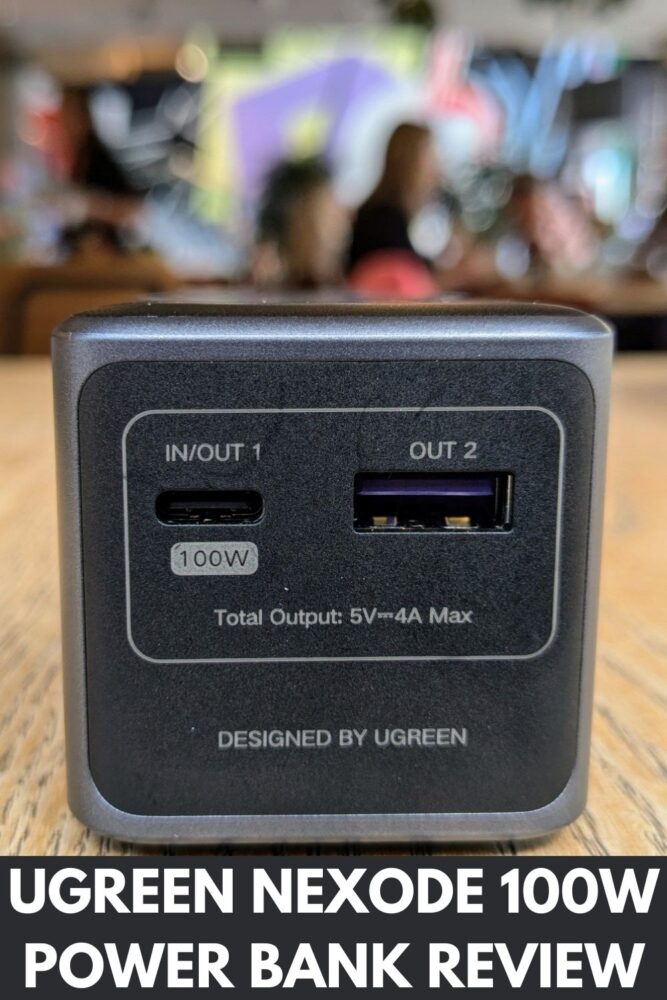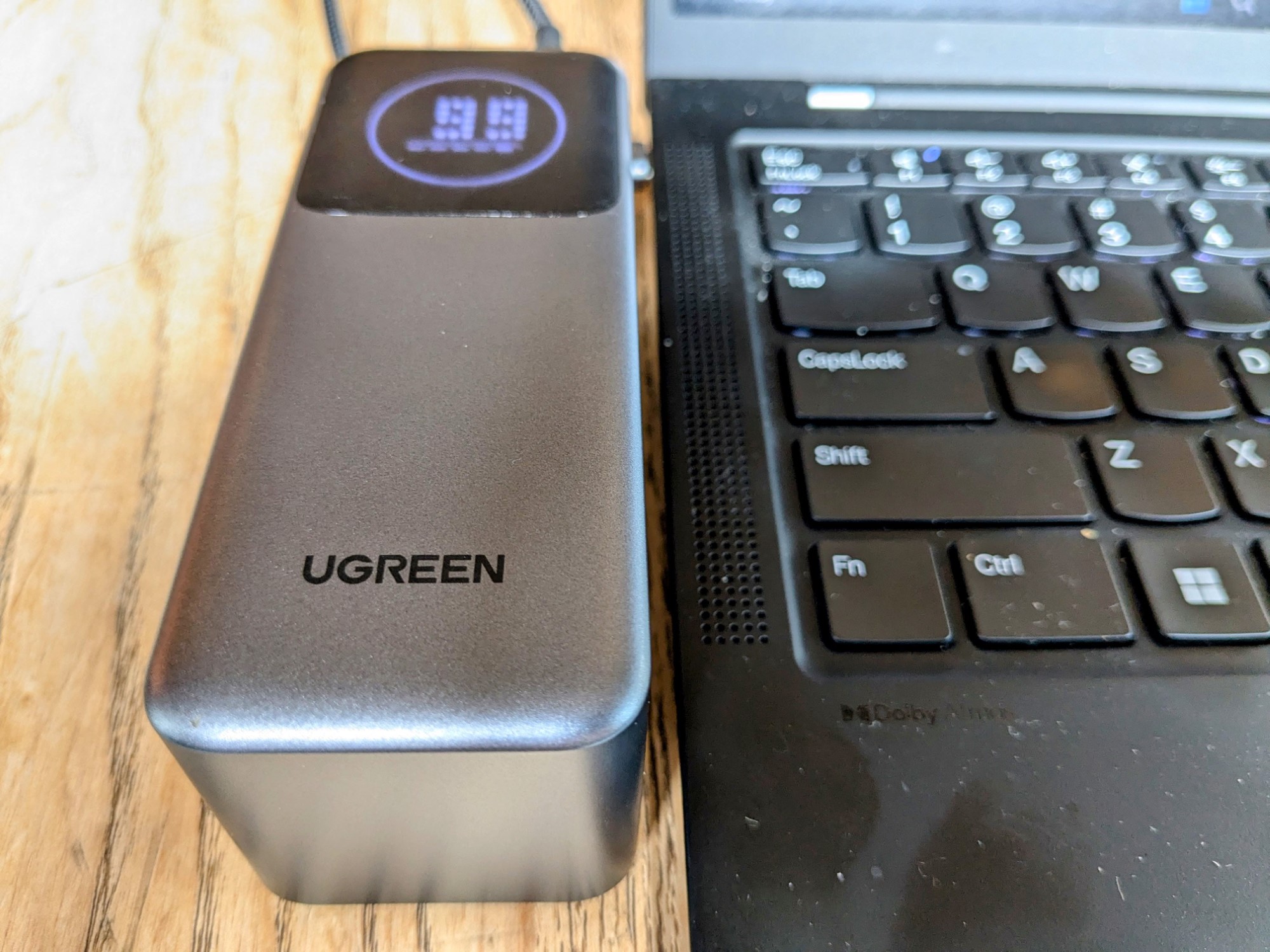When it comes to power banks, you’ve typically got two choices: small, light, and good for travel, or big, powerful, and hard to find space for in your bag.
The smaller ones typically have less battery capacity and a lower power output, which means they’re meant for charging things like phones and headphones. Large models, on the other hand, are often able to juice up a laptop as well, but their size and weight mean they’re not really practical for most travelers.
UGreen’s latest Nexode 100W 12,000mAh power bank tries to split the difference: it’s smallish and light enough to drop in a carry-on bag, but has enough power and capacity to let you squeeze out a few extra hours of work on the plane.
Or that’s the theory, at least. How does it work in practice?
To find out, I’ve been traveling with this model for the last few weeks, charging my phone on a 16-hour train ride in Kazakhstan, my laptop while working in coffee shops in the UK, and my earbuds when they tragically ran out of juice halfway through an overnight flight to Vietnam.
Here’s how it’s gone.
Design and Box Contents
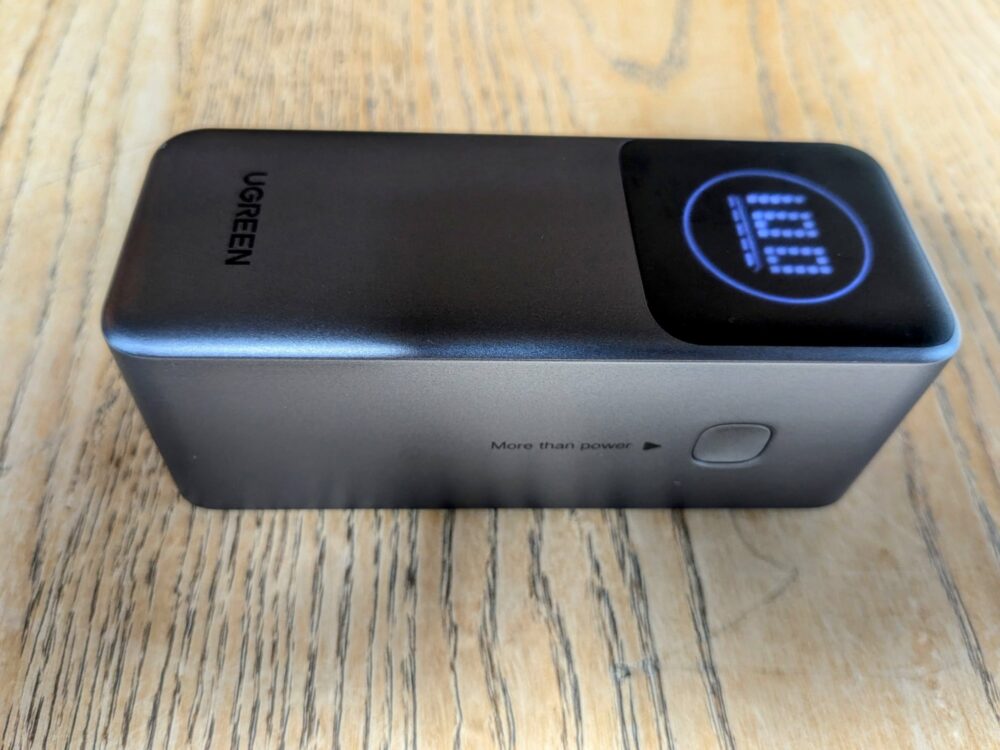

I don’t expect to get much in the box with these sorts of things, and UGreen didn’t do anything to change those expectations. Other than the power bank itself, there was just a small USB C to C cable and a collection of less-than-useful instruction booklets.
Picking up the power bank, I was immediately struck by two thoughts: it was noticeably larger than I expected, and given that, it was much lighter than I expected as well.
Measuring 4.5 × 1.8 × 1.8 inches, it’s not really the sort of thing you’ll drop in a pants pocket and forget about. I mean, yes, it does fit in the back pocket of my jeans, but only just. I’m certainly not going to wander around London all day with it sitting there.
That said, the unusual tall but narrow design does have its uses: it’s easy to hold in one hand, and fits easily into the side pocket of my daypack where a small drink bottle would usually go.
Despite being much bulkier than the Anker 533 that I reviewed last month, it’s only 3.5 ounces (100g) heavier. That’s not nothing, but given that it’s a more useful and versatile device, the 10.9oz total weight is something I’m happy enough to deal with.
The power bank seems pretty robust, although after three of weeks of use, I’m a bit sad there wasn’t a travel pouch of some sort in the box. There are already small scuffs and scratches on the display where it’s rubbed against something in my backpack, and they’ll only get worse over time.
Speaking of the display, it’s basic but does pretty much what you’d expect. Hit the power button on the side and you’ll get the exact remaining capacity (0-100%), which changes in real time as it increases or decreases.
After 20 seconds, the display switches to cutsey icons instead, which change along with the battery level. I don’t find them particularly useful, but they’re inoffensive enough. The screen dims after a minute, and switches off after three.
Both USB ports are on one end of the power bank, a USB C PD socket that can put out up to 100W, and USB-A with a 22.5W max output. That USB C port is also how you recharge the power bank, at up to 65W from a wall outlet if you’ve got a good charger.
Holding the power button down for three seconds switches both ports to trickle-charge mode for smartwatches and other low-power devices, while holding it for six seconds turns the power bank off entirely.
Testing
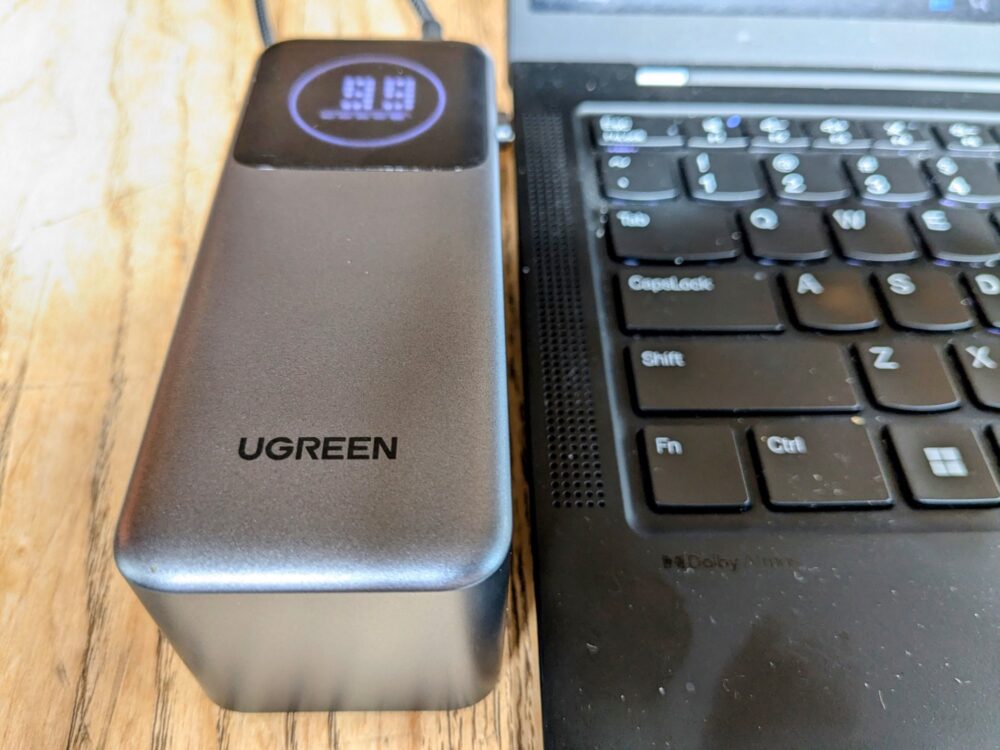

Because I’m traveling at the moment, I don’t have my usual USB power testers with me. I’ll update this review with the exact results when I get back, but for now, let’s just go with a more subjective approach.
As you’d expect, my phone (a Google Pixel 6a) reports that it’s “charging rapidly” whenever I plug it into the USB C port. There’s no such notification on iPhones, but the speed at which my partner’s iPhone 12 battery percentage goes up tells me that it, too, charges at top speed.
Starting from 20%, the Pixel took:
- 29 minutes to charge from 20 to 50%
- 40 minutes to charge from 50 to 80%
- 47 minutes to charge from 80 to 100%
In total, then, it took a bit over an hour to get from 20 to 80%. That’s normal for this phone: so-called “fast” charging isn’t all that rapid compared to others on the market.
Like all phones these days, charging slows dramatically after 80% to preserve battery health, so it’s no surprise that it took quite a while to hit full capacity: it’s the same from a wall charger.
By the time the phone was fully charged, the power bank had 69% of its own battery remaining.
After finishing with the Pixel, I plugged in the iPhone, which was also on 20% battery. With that, the stats were:
- 18 minutes to charge from 20 to 50%
- 26 minutes to charge from 50 to 80%
- 83 minutes to charge from 80 to 100%
When the iPhone finally ticked over to 100%, the power bank still had 51% remaining.
All of that to say, if you have a small to mid-size phone, expect to get at least a couple of full charges from this power bank. Large phones with huge batteries are a different story: you’ll get more than one charge, but probably less than two.
So far, so fine, but fast-charging a phone isn’t the reason you’ll buy this particular model. There are about a million similar power banks that can do the same thing in a smaller and/or cheaper package, so it’s really the laptop charging potential that makes it interesting.
To that end, I drained the battery on my Lenovo Thinkpad X1 to 15%, plugged in the fully-charged power bank, and left it to do its thing.
With the laptop set to not go to sleep and the screen at two-thirds brightness, it took 20 minutes to get to 40% and a total of 48 minutes to hit 72%. At that point the power bank ran out of juice and turned itself off.
That’s exactly the same charging rate as my usual 70W wall charger, and a more than useful amount of extra battery: for context, this laptop usually gets 7-8 hours from a full charge, so the power bank gave me around four more hours of work time.
Charging speeds were unsurprisingly lower from the USB-A port, but as long as that was the only port in use, my phone and earbuds still charged reasonably quickly.
That wasn’t the case with two cables connected, though: while it’s possible to charge from both ports at once, I wouldn’t recommend it unless you really aren’t in a hurry.
The charging speed dropped significantly with two cables connected: you certainly can’t power a laptop when doing so, and even with two phones, it’ll be faster to charge each one separately than plug them both in at once.
On the upside, as I mentioned earlier, fast charging isn’t a one-way street with this power bank: with a good wall charger, it doesn’t take long to top it back up again. Starting from empty with that same 70W charger, it took 45 minutes to get to two-thirds full, and 71 minutes to hit 100%.
That’s more useful than you might think, especially while traveling. Because the power bank charges faster than my phone, I found myself just quickly plugging it in at the hotel or airport, and then charging my phone from it at my leisure later.
I’d seen a few reports online of overheating issues with this model, especially while charging a laptop, but that wasn’t an issue for me. The power bank got warm to the touch after a while, but never any hotter than that.
My monitoring software showed a single minute where my laptop stopped charging while connected to the power bank, but it restarted immediately. I didn’t notice any glitches or slowdowns while charging either of the phones.
Get regular updates from the world of travel tech and remote work
News, reviews, recommendations and more, from here and around the web
Please enable JavaScript in your browser to submit the form
Verdict
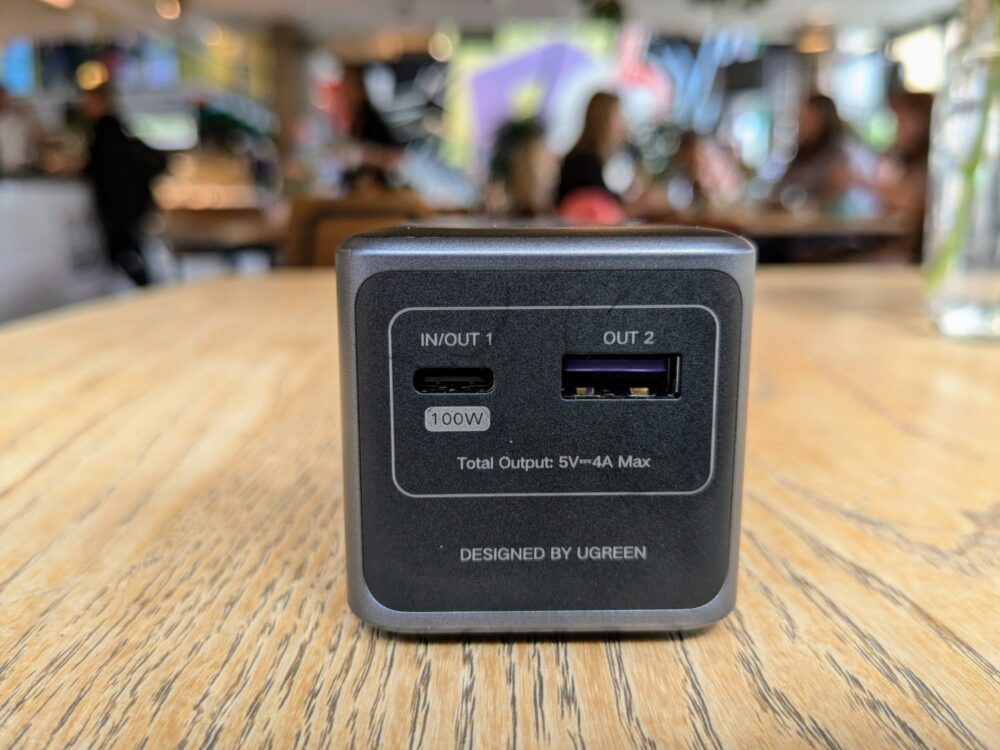

If you’re like me and have the need to charge a variety of devices outside the house, this UGreen power bank is pretty appealing. It’s a good way of fast-charging everything from phones and earbuds to tablets and laptops, at a size and weight that make it practical to travel with.
It’s not perfect: the lack of even a basic soft case feels like an oversight, at least based on the scratches that have already shown up, and the low power output when using both ports means that realistically you’re only going to use one at a time.
The size and weight are on the edge of what I’d consider appropriate for travel, but are far less of an issue if you’re just heading out for the day with a backpack or purse.
Pricewise, it’s far from the cheapest 10-15,000mAh power bank you’ll come across, but it’s the other specs that matter. Being able to get several hours extra runtime from most laptops is a gamechanger for a portable battery this size, and having fast charging both in and out is always useful when traveling.
Is this the ideal power bank for every situation? No, it’s not: if I only need to charge my phone once or twice and don’t care how fast it happens, I’ll put a smaller, lighter model in my pocket or bag and save myself the space and weight.
Likewise, if I’m going off-grid for several days, or have a lot of power-hungry devices with me that all need charging, it doesn’t really have enough capacity to last the distance. For that, UGreen makes higher-capacity 20K and 30K models instead.
For that middle ground, though, where size, weight, and charging speed are important, and I still need to be able to juice up a laptop now and again? This is the one that’ll be coming with me.
All images via author
